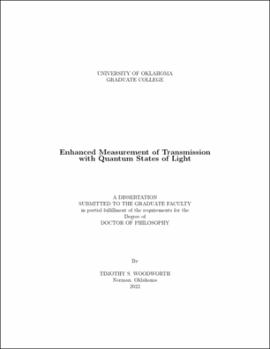| dc.description.abstract | Quantum metrology is the application of quantum mechanics towards the enhancement of
measurements. This is typically achieved through either quantum measurements, such as
photon counting, or using quantum states. In this thesis, we focus on the use of a high
power quantum state of light, known as the bright two mode squeezed state, to achieve
a quantum enhancement in the estimation of transmission by reducing the uncertainty in
the value down to the fundamental limit allowed by quantum mechanics. These bright two
mode squeezed states are of particular use to enhance the precision of many sensing devices
beyond the classical limit, via quantum enhancement, and current state-of-the-art due to
being generated at high power.
We start with an introduction to the theoretical calculations that set the fundamental
lower limit in the uncertainty in the estimation of a parameter, transmission in our case. This
limit is given by the quantum Cramér-Rao bound. We go over the bound for the bright single
mode squeezed state and calculate the bound for the bright two mode squeezed state. These
squeezed states offer a large enhancement in transmission estimation at high transmissions
compared to classical states. We also expand on these bound to include losses in the states
both before and after probing the transmissive system and detail measurements that are
able to saturate the quantum Cramér-Rao bound, even in the presence of loss. Operating at
this bound means that, for our state, no other estimation can do better.
We experimentally verify that we can estimate transmission at the quantum Cramér-
Rao bound for the bright two mode squeezed state. Achieving such uncertainty levels at
the quantum Cramér-Rao bound required extensive control of our experiment and precise
calibration of our state and system. In addition, we expand upon the calculations of the
quantum Cramér-Rao bound to include generation of the bright two mode squeezed state in
a more realistic system that takes into account the absorptive medium that is used.
Finally, we examine systems that have a resonant frequency dependent transmission and
phase responses. This allows us to compare and identify the optimal measurement parameter for use in estimating frequency shifts in the system response. We focus on systems
with resonance responses, in which there is a large change in transmission around a single
frequency. We show that for resonances with the common Lorentzian lineshape, the phase
measurement is in general more sensitive to frequency shifts than the transmission measurements. However, for lineshapes with a sharper change in transmission, we show that the
transmission measurement can do better than phase measurements. | en_US |

